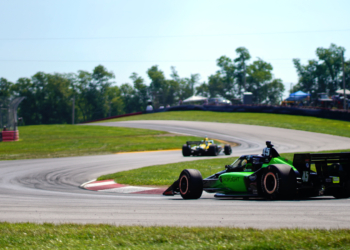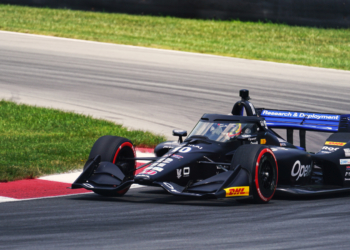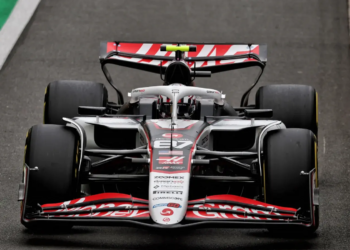Motorsport Week continues its Formula 1 team-by-team season review with Alfa Romeo, which took over naming rights from Sauber, and had a solid if unspectacular year after its predecessor's sizeable 2018 gains.
Sauber was 2018’s big improver as it rose from back-row misery to emerge as Formula 1’s midfield leader on merit in the closing events, spearheaded by standout component Charles Leclerc. Its rebranding as Alfa Romeo promised further gains but it had a topsy-turvy season in which its ambitions went largely unrealised.
It wasn’t necessarily that Alfa Romeo had a difficult season. It retained eighth and improved its tally from 48 to 57 points, the Brazil bonanza boosting its score. But overall up against strong, and largely improving, midfield rivals it too often fell on the wrong side of the fence.
It accepted it did not optimise weekends as it should have done, with practice pace often going unrealised, mistakes at pivotal moments proving costly, with the C38 slipping back as others gained. Race pace and tyre usage was also a relative weakness, with some race strategies either questionable or unfortunate, due to the Q2 tyre rule. Assuming the top three teams were out-of-reach, and with McLaren performing strongly, it left Alfa Romeo battling Renault, Toro Rosso and the ever-improving Racing Point for a handful of positions. In the exceptionally tight midfield someone has to miss out. And frequently that unwarranted honour fell to Alfa Romeo. There was nothing fundamentally flawed, nor outstanding, about Alfa Romeo’s C38. Sometimes it is that simple.
.jpg)
Off-track there remained murmurs that, despite being flushed with more resources year-on-year, they were not being optimised quite as effectively, amid suggestions that too many of the workforce were distracted by a close Ferrari alliance, and more of the stalwarts wanting to forge their own path. The regular and small updates yielded gains last season but this year they did not have the same impact. However, again the picture can be distorted by expectations. It only takes a couple of tenths to be on the wrong side of the points. It is no shame to be found ever so slightly lacking on occasion.
In Kimi Raikkonen and Antonio Giovinazzi Alfa Romeo had a line-up that blended experience and youth.
Raikkonen slotted back into Alfa Romeo – 18 years on from his stint as a rookie – with ease, cutting a far more relaxed and open figure compared to his time at Ferrari. Little wonder: fewer PR days, a job closer to home, and in a smaller environment. “Obviously the team is very close to where I live so I don’t need to travel to different countries, in many ways it helps, I have a bit more time to stay with the family,” he relayed. The presence of Raikkonen, and the return of the Alfa Romeo name, nonetheless gave the squad a higher profile than it has previously enjoyed and Raikkonen delivered early on, taking points across the opening four rounds. But thereafter it was more profligate, with Raikkonen taking just a solitary top 10 finish – the outstanding fourth in Brazil – from the final nine events.
“I think it’s two different halves of the year where the first part of the year was pretty decent and most of the races and also we had some bad races around Barcelona, Monaco but it improved from there,” said Raikkonen. “Since the summer break, first we had good speed still but didn’t score any points as a team and then it’s been very difficult apart from the last couple of races where we at least had some speed to fight in the top 10. Only in [Brazil] could we score good points with two cars but it’s a bit too late, looking more as a team halfway through but that’s how it goes. I think we learned some things; we brought a new front wing [in Brazil] which helped a bit, so we’re still trying to improve so it’s all learning for next year and we try to do a better job as a team.”
.jpg)
For Giovinazzi it was his first real shot at the big time, keen to remind observers that not only was he paired with a World Champion – an advantage (the ideal teacher) and disadvantage (a big experience deficit) in equal measure – but that he was to all intents and purposes a rookie. In the midst of a fiercely competitive midfield it was little surprise that Giovinazzi, having been out of full-time racing since he finished as GP2 runner-up in 2016, was slightly off the pace. But after that slow start he chipped away at the ultimate pace both in qualifying and in race trim, as the benefit of experience began to pay off. He scored just one point prior to the summer break, and squandered a top 10 finish in Belgium, but bounced back with a superb ninth days later on home soil in Italy, and was slightly unfortunate in that his more rounded displays came once Alfa Romeo had slipped back. His seat was not secure for several months, amid suggestions that boss Frederic Vasseur tried to persuade Ferrari – which has an influence on the position – that Nico Hulkenberg was a more suitable choice, but Giovinazzi was eventually given the nod.
“For sure next year I will be much more ready in terms of experience and everything,” said Giovinazzi. “I want to do another step on the race pace, to understand better these things, so I will work really hard on this side and still push for quali, which I think at the end of season was quite good but still want to do more, so we’ll see.” For Giovinazzi in 2020 there will surely be a carrot and a stick: perform well – and if Sebastian Vettel opts to depart – then he could be a contender to join Charles Leclerc in 2021. Fail to improve and the plethora of hot-shot Ferrari juniors ready to battle it out in Formula 2 will be primed to grab his seat.
What to make of Alfa Romeo’s season? Good, not great, some highs, some lows. It has consolidated its 2018 gains and, considering that progress, it is easy to forget that just two years ago it was mired in back-of-the-grid anonymity. Will it be better in 2020? As Raikkonen often says, we’ll have to wait and see.
.jpg)






